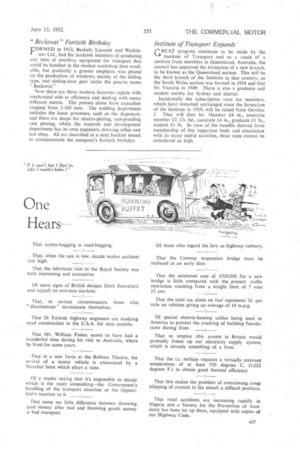Passing Comments
Page 28

Page 29

If you've noticed an error in this article please click here to report it so we can fix it.
The Future Position of Steel
PROBLEMS likely to face the'steel industry in the future have been studied by the United Nations Economic Commission. The Secretariat estimates that Europe may obtain 80 per cent. of the future world market, provided that its steel be competitive in quality and price with that of its two principal rivals, the U.S.A. and Japan. When the defence programmes are completed, there may be a surplus to demand unless measures be taken soon to develop avenues of consumption and export. Growth in consumption in under-developed countries depends, however, upon the pace of general economic development, and this could be accelerated by assistance from those more :advanced.
Reminiscences from Lord Brabazon
SPEAKING recently at the annual luncheon of the Maudslay Society, Lord Brabazon, P.C., M.C., referred to an amusing incident ,concerning himself which occurred in one of the earliest tests of motor vehicles, the second Thousand Mile Trial. The vehicles returned daily to the Crystal Palace and, in those days when dustless roads were not known, the drivers were thickly coaled with dust.
It so happened that " Brab " saw on exhibition there what was probably the earliest vacuum cleaner, and by arrangement with the demonstrator of this machine, he stood each nittht on a platform before
an admiring audience and was vacuum-cleaned, the quantity of 111th removed being shown in a bottle. He now prides himself that he was one of the first people to make this useful appliance popular.
As an example of how soon some hitherto famous men are forgotten, he mentioned that soon after the 1914-18 war, he gave a dinner in honour of Santos Dumont, but not one of the six guests he had invited had ever heard the name. For those of our readers who are in like circumstances we may mention that this aviator flew several times around the Eiffel Tower in a dirigible balloon.
Uses for All-Glass Paper
("LASS is the latest material from which to make filters. Bundles of commercial glass fibres are mixed with water in a paper beater for sufficienttime to separate the fibres. The material then flows on to a paper machine with a wire screen of 70 mesh, 33-ft. long. It then passes through rollers and driers. This glass paper, 0.010 to 0.014 in. thick and weighing 4.0-51 lb. per ream, is cut into sheets measuring 25 ins. by 40 ins. Tests in a smoke-filled room showed that only one smoke particle in 100,000 will pass through such a filter. As the material has excellent electrical and heat-resisting properties, it can also be used for insulation purposes and condensers. No doubt other uses for the material will be found.
" Beclawat" Fortieth Birthday
FORMED in 1912, Beckett, Laycock and Watkinson Ltd., had the laudable intention of producing any item of ancillary equipment for transport that could be handled in the modest workshop then available, but gradually a greater emphasis was placed on the production of windows, mainly of the sliding type, and sliding-door, gear under the generic name " Beclawat."
Now there are three modern factories replete with mechanical aids to efficiency and dealing with many different metals. The presses alone have capacities ranging from 2-100 tons, The welding department includes the latest processes, such as the Argonarc, and there are shops for electro-plating, rust-proofing and glazing, whilst the research and development department has its own engineers, drawing office and test shop. All are described in a neat booklet issued to commemorate the company's fortieth birthday.
Institute of Transport Expands
ir,REAT progress continues to be made by the 1'1 Institute of Transport and as a result of a petition from members in Queensland, Australia, the council has approved the formation of a new branch, to be known as the Queensland section. This will be the third branch of the Institute in that country, as the South Wales section was formed in 1934 and that for Victoria in 1949. There is also a graduate and student society for Sydney and district.
Incidentally the subscription rates for members, which have remained unchanged since the formation of the Institute in 1919, will be raised from October 1. They will thenbe: Member £4 4s., associate member £2 12s. 6d., associate £4 4s,, graduate £1 5s., student £1 5s. In view of the benefits derived from membership of this important body and association with its many useful activities, these rates cannot be considered as high.




















































































